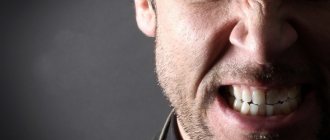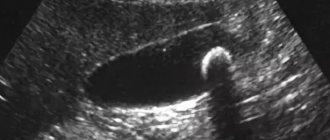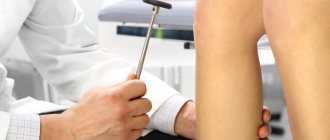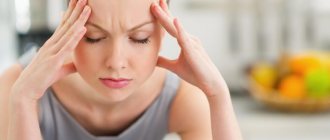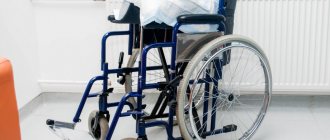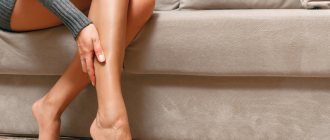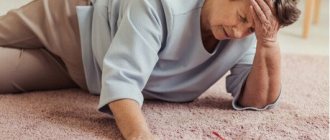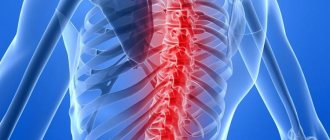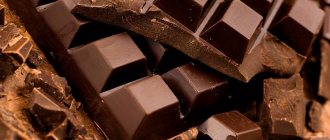A stroke is an acutely developing deviation of cerebral circulation, which is caused by spasm, sudden rupture, blockage of cerebral vessels by a thrombus or embolus, leading to disruption of the functioning or integrity of cerebral vessels, significant disruption of the functioning of brain tissue or hemorrhage in them. As a result of such disorders, the affected area of the brain suffers from oxygen starvation and its tissues are subject to destruction and death. In the future, such changes lead to disability, and in severe cases, death can occur.
Stroke and its types
A stroke is a brain injury in which blood vessels rupture or become blocked. Because of this, cells die, since they are not supplied with blood and oxygen. If a person is not treated promptly, brain damage can become irreversible, ultimately leading to death.
A stroke can be left-sided or right-sided. In the first case, pain appears in the right half of the body, in the second - in the left.
There are two types of stroke:
- Hemorrhagic
. The reason for the development of this form is the rupture of a blood vessel located in the brain. This occurs due to high BP (blood pressure). Cerebral hemorrhage is often fatal. Such a stroke occurs suddenly - the patient feels a sharp pain in the head, similar to a blow, then the skin of the face turns red, the victim breathes noisily and hoarsely. Frequent companions of such a stroke are lethargy and vomiting. - Ischemic
. This form develops due to blockage of a blood vessel. Such a stroke does not occur instantly; it can be recognized by warning signs. There is no loss of consciousness in this form, but the victim feels sick. Sometimes you feel better, but this effect is temporary.
Stroke is divided into three degrees of severity. If it is mild, the patient usually recovers after undergoing a course of treatment and rehabilitation. Moderate and severe stroke leads to death in 20% of cases, and up to 80% of victims become disabled.
Diagnosis and differential diagnosis
Early diagnosis is of great importance for the correct selection of treatment tactics
ischemic and hemorrhagic stroke. It is worth considering that accurate clinical diagnosis of the nature of the disease is possible only in 70% of cases. To identify the presence of foci of hemorrhagic damage, a patient's medical history is collected, a complete examination, a blood test, a cardiogram, ultrasound of the heart and extracranial arteries, magnetic resonance imaging, computer diagnostics and transcranial Doppler sonography.
Prehospital diagnostics
Prehospital diagnosis ranks first in determining the patient's condition. First of all, the condition of the blood vessels and heart, and respiratory functions are assessed. During a neurological examination, the doctor clarifies the level of consciousness and conducts a typical diagnosis of focal brain lesions.
Instrumental diagnostics
During the acute period of ischemic cerebral infarction, magnetic resonance imaging is performed, as the method is considered the most effective in terms of early visualization. On a standard tomogram, more than 80% of ischemic changes become visible already on the first day of observation.
With computed tomography, a zone of reduced density can be detected 12-24 hours after the development of the disease. If it is less recent, the disease is detected in less than half of the cases. Lacunar infarcts and infarcts in the brain stem are often not detected on non-contrast computed tomography even after 3-5 days.
Differential diagnosis of various types of stroke
In medicine, differential diagnosis is a way to exclude a disease that is inappropriate based on symptoms and factors. This method may require a lumbar puncture. It is carried out only in the absence of contraindications, such as displacement of the midline structures by more than 5 mm. They can be seen using computed tomography or magnetic resonance imaging. In ischemic stroke, the cerebrospinal fluid is clear and contains normal amounts of protein and other cellular elements.
Causes and risk factors
Advertising:
Impaired blood flow to the brain is the main cause of stroke. It is because of this that rupture or blockage of blood vessels occurs. Blockage can occur due to the following reasons:
- thrombosis (often due to atherosclerosis);
- embolism.
Arterial rupture is caused by:
- serious injuries to the skull and brain;
- arterial hypertension;
- aneurysm and other pathologies of arterial walls.
There are risk factors that predispose to stroke:
The child's organ system is formed after conception has occurred, but sometimes a hole forms between the cavities of the heart valves and the process is disrupted. Read more in the article: “VSD in a newborn.”
| Risk factor | Description |
| Age and gender | With age, the risk of developing the disease increases (usually it develops after 40-45 years). Stroke is more common in men |
| Heart diseases | Arrhythmias, heart failure and other pathologies of the cardiovascular system increase the risk of stroke |
| Hypertension | High blood pressure increases the risk of stroke by 4 times if it exceeds 160/95 mmHg. Art., and 10 times if the readings are above 200/115 mm Hg. Art. |
| Smoking | Men who smoke often develop atherosclerosis, which doubles the risk of stroke |
| Diabetes | The danger of this disease is hypertension and atherosclerosis |
| Oral contraceptives | Drugs that contain high amounts of estrogen (more than 50 mg) can increase the risk of stroke. The combination of taking OCs with high blood pressure and smoking is especially dangerous. |
Precursors and first signs of stroke in men
Advertising:
To successfully fight the disease, or even prevent it, you need to know about the earliest signs - the warning signs of a stroke. There is reason to be wary if men are bothered by frequent headaches, weakness, dizziness, and nausea. Perhaps these are the first signs of a dangerous disease. In addition, symptoms such as a rare pulse, sweating, blood flow to the face, disturbances in movement and speech, and numbness of the limbs, usually on one side, may occur.
Watery pimples on the body of an adult or child look like cavities raised above the skin level, filled with transparent watery exudate or yellowish ichor. Read more in the article: “watery acne on the body.”
Every man should know the main signs of a stroke, the severity of which can vary. These include:
- Sudden weakness and severe headache.
- Unsteady gait due to lack of coordination of movements.
- Speech disorder.
- Visual and hearing impairments.
- Foggy consciousness.
- Difficulty in perceiving what is happening around.
- Numbness of the right or left side of the body.
- Drooling and difficulty swallowing.
These stroke symptoms are short-lived, mild, and may disappear soon. But it should be remembered that such a mini-attack may soon be followed by a real stroke (mild, moderate or severe). To prevent a recurrent attack, you should consult a doctor immediately after the alarm.
Advertising:
Depending on the location of the damaged area of the brain, dysfunction may be temporary or irreversible. During a stroke, signs such as a rare pulse and pressure changes are observed. The frequency and depth of breathing changes, complete or partial paralysis occurs, and coma is possible. In severe cases, cardiac arrest may occur.
The disease can be recognized by the following signs:
| Sign | Description |
| Violation of facial symmetry | A person suspected of having a stroke should smile (if the disease develops, the smile is asymmetrical) |
| Speech dysfunction | Ask the man to say some simple phrase (with a stroke, a person is not able to pronounce words correctly and form sentences from them) |
| Muscle weakness | If the victim raises both arms in front of him and holds them in this position, one of them will involuntarily drop |
If any of these signs are present (especially if there are several of them at once), the patient should quickly provide first aid, as this can save his life. Before doing this, be sure to call a team of doctors.
How can I help?
Advertising:
First aid for hemorrhagic stroke is as follows:
- Do not try to return the person to consciousness on your own, but be sure to monitor so that the tongue does not sink in, which can block the patient’s airway. If you have dentures in your mouth, they must be removed.
- The patient should be laid horizontally, with his head slightly raised and tilted to the side.
- If the attack occurred on the street, the person should not be allowed to go home or take any medications until doctors arrive. The patient can be placed on a bench or even on the grass in a park.
- Remove any items of clothing that may impede breathing, such as a tie or belt, and unbutton your collar to allow fresh air to enter.
- A cold compress should be applied to the patient's head. This could be meat from the freezer, or a bottle of mineral water. Moreover, the compress is applied to the head on the side opposite to the numb one.
- If a stroke is accompanied by vomiting and increased salivation, you need to clean the mouth with a piece of natural tissue.
- If possible, maintain blood circulation in the extremities by covering the patient or applying a heating pad.
- In case of paralysis, it is advisable to rub the limbs with a mixture of vegetable oil and alcohol (2:1) before the doctors arrive. This will alleviate the patient's condition.
Advertising:
The first thing to do is call an ambulance. Provide the patient with a horizontal position, free the neck from clothing. Do not try to give water or food to the patient, this should not be done. Do not give painkillers or other drugs. You can easily massage numb limbs. Don't panic, act calmly until the medical team arrives.
Treatment and care
Stroke treatment is carried out under constant medical supervision in a hospital setting. The injured man is advised to take drugs that improve metabolism in the brain, as well as oxygen therapy and rehabilitation (this includes: massage, physical therapy (PT), physiotherapy).
A man who has suffered from a stroke is prescribed bed rest. In the ischemic form, it lasts up to 5 days (provided there are no progressive symptoms), sometimes this period increases to 2 weeks. In the hemorrhagic form, the patient is on bed rest for 1 to 6 weeks.
During the period of movement restriction, the patient is recommended to tightly bandage his legs or wear compression stockings (these will help avoid blood clots). If this measure does not help, the doctor prescribes heparin injections (intravenous and subcutaneous). After completing hospital treatment, a rehabilitation period begins.
Treatment of ischemic stroke
When treating ischemic stroke, it is necessary to act quickly and clearly. In the acute period of the disease, the patient must be urgently hospitalized.
First aid to a patient
Before emergency medical services arrive, you must:
- Place the patient on high pillows.
- Open the window so that there is an influx of fresh air, unbutton the collar of your shirt, take off tight clothes, a belt, a belt.
- Measure blood pressure using a tonometer. If it is elevated, it is necessary to give the patient’s usual medicine or immerse his feet in warm water.
- The patient must take medications that protect nerve cells. For example, drugs-matabolites of brain activity.
It is worth remembering that in case of acute stroke it is prohibited to take any vasodilators. Under their influence, the lumens of blood vessels in undamaged areas of the brain become larger, as a result of which the blood tends to cover all areas, and oxygen starvation begins in the damaged areas.
Drug therapy
Treatment of ischemic stroke should primarily be aimed at restoring damaged areas of the brain and protecting nerve cells. Recovery occurs with the help of a group of drugs such as neuroparants. Healthy nerve cells are protected by neuroprotectors. Some medications combine both of these effects, so they can be used in the complex treatment of ischemic stroke.
In addition to treating nerve tissue, it is also important to pay attention to those diseases that can provoke the disease again. The patient must undergo a full range of studies aimed at controlling dangerous diseases.
Even before hospitalization, the patient receives basic therapy from emergency doctors, which continues in the emergency room. It is necessary to stabilize the patient’s condition and support the performance of systems and organs. Therapy includes:
- Body temperature control. If the value of 37.5°C is exceeded, drugs from the group of analgesics-antipyretics are used.
- Relieving headaches. Nonsteroidal anti-inflammatory medications are administered to relieve pain.
- Relieving cramps, if present.
- Maintaining water and electrolyte balance by administering solutions that maintain blood osmotic pressure.
- Control and adjustment of heart activity.
- Correction of blood pressure.
- Monitoring blood glucose levels.
Specific treatment after ischemic stroke is anticoagulant and thrombolytic therapy.
Drugs for ischemic stroke
Treatment of the disease is based on drugs that thin the blood and dissolve blood clots. Liquefaction of blood clots reduces the level of damage to brain tissue during a major stroke, and also improves the future prognosis for the patient’s health. It makes sense to carry out drug therapy in the first hours after an attack. What to take one year after an ischemic stroke is determined by the attending physician.
Operation
If an ischemic heart stroke is diagnosed, treatment may even include surgery. For example:
- anatomical bypass surgery;
- installation of stent grafts in the carotid artery;
One of the most common ways to reduce the negative consequences of a stroke is thrombolysis. During angiography, medication is injected into the site of the blood clot. Thus, the blockage disappears and normal blood circulation is restored.
Additionally, medications are used that significantly improve metabolic processes in the brain. Therefore, treatment of ischemic stroke is more effective and faster. If the disease is diagnosed on time and the patient receives timely medical care, then there is a high chance that irreversible brain damage has not yet occurred.
Nutritional Features
A patient who has suffered an acute ischemic stroke is very weak at first. Therefore, even ordinary eating or drinking requires enormous effort. For approximately the first three weeks, the patient is fed in a supine or semi-recumbent position. You should start eating with pureed viscous porridges or soups, vegetable purees. Then the diet can be gradually expanded.
Basic principles of nutrition for a patient after a stroke:
- Easily digestible food is given that does not require special energy consumption during digestion;
- food should be nutritious, but low in calories;
- products should not contain cholesterol, or their quantity should be minimal;
- It is prohibited to eat hot or cold food; all dishes must be warm or at room temperature;
- It is recommended to drink from 1.5 to 2 liters of pure water so that the water and electrolyte balance is normal;
- The portion size should be reduced, but the number of meals should be increased;
- Drinking alcohol or smoking is prohibited.
In order for recovery to occur faster, the body must be replenished with macro- and microelements and vitamins. The patient’s diet after suffering a pathology should consist of:
- Vegetables and fruits. They contain a large amount of vitamins. You should consume approximately 400 grams of them daily. Carrots, eggplants, cabbage, cucumbers, tomatoes, beets, pumpkins, apples, bananas, plums, and peaches deserve special attention. It is preferable to eat them baked or boiled; small quantities can be eaten raw.
- Freshly squeezed juices, natural fruit drinks, decoctions of herbs and rose hips, green and weak black tea are the main types of drinks that should be included in the diet.
- Dairy dishes. Cottage cheese and fermented milk dishes will help you forget about constipation. At the same time, it is forbidden to take fatty dairy products: condensed milk, cheese, cream. Dairy products can be consumed 2-3 times a week.
- Low-fat boiled fish. Several times a week, the diet should include salmon, mackerel, sardine, pike, cod, perch, flounder, and navaga.
- Meat products. Meat helps restore nerve cells and helps gain muscle mass. Turkey, rabbit, chicken and veal deserve attention.
- Eggs. It is recommended to use 3-4 pieces per week.
Foods that need to be cooked should be baked or boiled. You can steam it, but avoid fried foods.
It is prohibited to consume soups prepared with fish or meat broth and containing legumes. Porridge and vegetables can be seasoned with vegetable oil.
To add piquancy to the dish, you can add seasonings such as:
- mint;
- rosemary;
- parsley;
- Bay leaf;
- lemon;
- khmeli-suneli;
- dried currant and cherry leaves.
Among sweets, marmalade and biscuits are allowed. The diet can include bread of grades I and II.
Aftermath and recovery
There are several of the most common consequences of a stroke. Among them:
- Impaired motor activity - paralysis, loss of coordination. Often such complications are observed in a specific area of the body; an arm may fail, muscles on half of the face may weaken, etc.
- Speech disorders, problems with swallowing. This is due to loss of control of the muscles in the mouth and throat.
- Attention problems and short-term memory loss.
- Mental changes. They can be associated both with damage to specific areas of the brain, and with general stress caused by the loss of other functions - movement, speech, vision and others.
- Pain. Such consequences after a stroke are more associated with disruption of signal transmission from the nerve to the brain (phantom pain).
Most often, patients are prescribed rehabilitation, which should restore motor activity and speech.
Advertising:
- Physiotherapy. If there are no contraindications, it can be started already in the first days after a stroke. At first, the movements are not made by the patient himself, but by a rehabilitation therapist who kneads and bends the joints. Gradually the set of exercises becomes more complicated. At a certain stage, special simulators and electrical stimulation of the neuromuscular system can be used.
- Classes with a speech therapist-aphasiologist to restore speech, as well as writing, reading, and counting skills. This therapy necessarily includes homework, and the success of general therapy greatly depends on how the doctor’s advice is followed. For example, constant verbal contact with loved ones at home and in the hospital plays an important role.
Video - Rehabilitation exercises after a stroke
Rehabilitation of ischemic stroke
Not everyone knows what to do after an ischemic stroke. During the recovery period, the first three months after the disease are most important. Rehabilitation must be comprehensive. This may include:
- restoration of musculoskeletal functions;
- restoration of speech and swallowing functions;
- proper diet that meets the requirements;
- regular blood pressure monitoring and drug therapy;
- symptomatic treatment;
- returning control to the pelvic organs;
- treatment of depression with the help of an experienced psychologist.
Massage, manual therapy and passive exercises
These auxiliary measures are aimed primarily at restoring the musculoskeletal system and the functioning of internal organs. Regular sessions will help relieve headaches, dizziness and problems with the gastrointestinal tract.
Therapeutic exercises
Therapeutic exercise is effective in the rehabilitation of sick and disabled people, as well as in preventing the recurrence of the disease. Exercises are carried out under the supervision of the attending physician.
Physiotherapy
Physiotherapy involves the therapeutic use of various physical means: movement, heat, fluids, etc. The method has a gentle effect on the body, stimulating recovery processes. Thanks to a combination of techniques, tight muscles are relaxed, vertebral mobility is restored and the condition of the intervertebral discs is normalized.
Prevention
To avoid recurrent strokes, you should lead a healthy lifestyle and limit fatty and fried foods in your diet. For prevention purposes, it is recommended to use antiarrhythmic drugs, and to prevent the formation of blood clots, the use of anticoagulants is prescribed. Only the attending physician can prescribe medications; self-medication in this case is unacceptable.
Prevention will help reduce the risk of disease to a minimum.
It is better to know everything about ischemic stroke in advance in order to avoid it. It is also important to study the symptoms of ischemic stroke well in order to begin treatment on time.
Disease prevention measures
Stroke prevention consists of a set of measures to organize a healthy lifestyle:
- control your blood pressure in the morning and evening (optimal systolic (upper) pressure should be in the range of 110-139 mm Hg. If your readings regularly increase, consult your doctor to prescribe medication;
- monitor cholesterol levels, as its high content provokes hardening of blood vessels;
- switch to a healthy diet - reduce salt intake, increase the amount of vegetables and fruits. Make changes to your diet gradually. Avoid snacking on the go and overeating, especially sweets and sausages;
- go in for sports - moderate physical activity (cycling, jogging, gymnastics, walks in the fresh air, swimming, tennis);
- limit your consumption of alcoholic beverages. Without serious consequences for the body, it is permissible to consume 20 grams of pure alcohol per day (this is a bottle of beer, 2 glasses of wine or 50 grams of high-quality vodka);
- undergo annual medical examinations upon reaching 40 years of age (ultrasound of the heart and blood vessels, ECG, biochemical blood test, MRI of the brain).
- eliminate increased psycho-emotional stress and stress. If you cannot completely limit yourself from them, protect the nervous system with plant-based sedatives (Fitosedan, Persen, Tenoten, Afobazol, Herbion, etc.);
- stop smoking.
Chronic stress, snacking on the go, and unfavorable environmental conditions lead to decreased vascular function, which reduces blood supply to the brain. If one of the provoking factors is present, the specialist draws up an individual program for the prevention of hemorrhagic stroke.
Stroke is a fatal disease that affects men over 40 years of age. Smoking and constant stress increase the risk of its development, so you should get rid of all bad habits, be less nervous and be examined at least once a year in a medical facility. Remember that any disease, including stroke, is easier to prevent and prevent than to treat serious complications.
Stroke is an acute circulatory disorder in the brain that causes damage and death of nerve cells.
The danger of a stroke lies in its unexpected and very rapid development, which in many cases ends in death, therefore, at the first signs of a stroke, emergency medical attention is required! Prompt medical attention can minimize brain damage and prevent possible complications.
Another unpleasant “surprise” that a stroke brings is the disability of the person who experienced it, because Statistics say that 70-80% of people become disabled after a stroke.
Stroke includes the following pathological conditions, or its types: cerebral hemorrhage, cerebral infarction and subarachnoid hemorrhage.
Causes of stroke
As you and I already know, dear readers, a stroke occurs as a result of a circulatory disorder in a certain area of the brain. This disorder, or pathology, occurs due to blockage and rupture of a brain vessel. Let's look at what actually can provoke this circulatory disorder?
Factors that increase the likelihood of developing a stroke:
- hypertension (hypertension - high blood pressure); - stenosis of the carotid arteries; - thrombosis; - embolism; - blood clotting disorder; - cerebral aneurysms; - heart rhythm disturbances; - atherosclerosis and other cardiovascular diseases; - diabetes; — bad habits (smoking, drinking alcohol and drugs); - insomnia; - obesity; - sleep apnea - stopping breathing for more than 10 seconds; - hypothermia of the body; - injuries; - age - with increasing age, the state of health of blood vessels and heart.
Types of stroke
Ischemic stroke (cerebral infarction)
This type of stroke occurs most often - in 90% of all cases. It occurs as a result of narrowing or blocking of the arteries of the brain, due to which the blood flow in it is sharply reduced - ischemia. Due to the lack of blood flow, brain cells are deprived of nutrients and oxygen and can begin to die within just a couple of minutes.
Hemorrhagic stroke (intracerebral hematoma)
Accounts for approximately 10% of cases of the disease. A hemorrhagic stroke occurs when a blood vessel leaks or ruptures.
Transient ischemic attack (TIA) or ministroke
This type is characterized by a short-term (less than 5 minutes) episode of stroke symptoms.
In a mini-stroke, a blood clot disrupts blood flow to part of the brain, but does not cause significant damage because the blockage of the vessel is temporary.
Important! With a mini-stroke, as with a stroke, it is necessary to urgently call an ambulance, even if the symptoms have completely disappeared. Symptoms of a mini-stroke indicate that the vessels leading to the brain are partially blocked or narrowed and there is a risk of developing a stroke.
The first signs and symptoms of a stroke
Important! If symptoms of a stroke appear, call an ambulance immediately!!!
Symptoms of a stroke:
- sudden weakness; - paralysis or numbness of the muscles of the face, limbs (often on one side); - speech impairment; - blurred vision; - severe sharp headache; - dizziness; - loss of balance and coordination, gait disturbance.
How to recognize a stroke in a person?
If you notice that a person is not behaving naturally, then do not rush to think that he is drunk; perhaps the person is having a stroke. To recognize this disease, pay attention to the following points:
Stroke recognition technique “UZTs”:
- U - smile. During a stroke, the patient’s smile is usually crooked; the corner of the lips on one side may be directed downward rather than upward.
- S - speak. Say a simple sentence, for example: “The sun is shining outside the window.” With a stroke, pronunciation is often (but not always) impaired.
- P - raise your hands up. If your arms do not rise at the same rate, this may indicate a stroke.
“IMPACT” stroke recognition technique:
- U - smile. After a stroke, the smile becomes crooked and asymmetrical;
- D - movement. Raise both arms and both legs up at the same time - one of the paired limbs will rise slower and lower;
- A - articulation. Say the word “articulation” or several phrases - after a stroke, diction is impaired, speech sounds sluggish or simply strange;
- R - solution. If you find violations in at least one of the points (compared to the normal state), it’s time to make a decision and call an ambulance. Tell the dispatcher what signs of a stroke (STROKE) you have found and a special resuscitation team will arrive quickly.
If you detect signs of a stroke in a person, call an ambulance immediately!!! The faster qualified assistance is provided, the greater the chances of eliminating the consequences of this disease!!!
If you notice signs of a stroke in a person, you must:
- Position the patient so that his head is elevated approximately 30°.
- If the patient loses consciousness and ends up on the floor, move him to a more comfortable position.
- If the patient has prerequisites for vomiting, turn his head to the side so that the vomit does not enter the respiratory system. If this has already happened, it is necessary to clear the airways by placing the patient on his side and clean the oral cavity.
- Do not let the patient drink or eat food, because if he has spasms in the respiratory tract, he may suffocate.
- Make sure the victim has fresh air available. Open a window or window to allow fresh air into the room. Remove tight clothing, unbutton your shirt collar, or loosen your tight belt or waistband.
- If possible, measure your blood pressure and glucose levels. The recorded indicators must be recorded and reported to the arriving doctors. It should also be noted that if the pressure is high, you should not immediately lower it, because In the first hours of a stroke, increased blood pressure is a necessary norm due to adaptation of the brain. Only over time can the patient be given medication that lowers blood pressure.
- If his pulse cannot be felt, his heart has stopped and his breathing has stopped, immediately begin chest compressions and mouth-to-mouth or mouth-to-nose artificial respiration. Everything else is the task of emergency medical services.
Consequences of a stroke
Each person experiences the effects of a stroke differently. Some people, thank God, have no consequences, others may have temporary or permanent disabilities, for example:
- paralysis or loss of muscle movement; - speech or swallowing problems; - memory loss or difficulty understanding clearly; - pain or numbness in some parts of the body; - loss of ability to take care of oneself.
Remember that a person who has suffered a stroke needs care, love and understanding. Help such a person, be patient
Stroke treatment
Stroke treatment consists of 3 stages:
— provision of emergency medical care; - hospital inpatient facility; — rehabilitation (recovery).
In the first hours of a stroke, doctors provide emergency care.
In the first days in hospital, intensive therapy is provided, which reduces the risk of death, reduces brain damage and prevents the occurrence of a recurrent stroke.
Important! Many different medications can be used to treat any type of stroke, but remember - all medications can only be prescribed by your doctor and should be taken strictly as recommended!
Over the next weeks and months , the patient is prescribed medications, and his health status is constantly monitored (repeated examinations are carried out and tests are taken).
After treatment, the person is rehabilitated in the form of various procedures, physical therapy and massage.
Treatment of ischemic stroke
Treatment for this type of stroke aims to dissolve the clot that is blocking the flow of blood to the brain. Also, during treatment, doctors try to prevent recurrent stroke and other possible complications. For this, medications are used in the form of tablets, injections, droppers and various medical procedures.
Medicines prescribed for the treatment of ischemic stroke:
Tissue plasminogen activator. This is the main medicine that treats ischemic stroke by dissolving blood clots. But it is not suitable for everyone, as it has clear recommendations for use, many contraindications and side effects.
The drug can be used no later than 3 hours after the artery supplying the brain is blocked by a blood clot. It is best when the drug is administered to the patient within an hour of the onset of the stroke. If more than 3 hours have already passed, then the risk of using this drug is higher than the expected benefit. In 6% of people, administration of the drug can cause a hemorrhagic stroke; people over 75 years of age are especially susceptible to this course of events.
Tissue plasminogen activator can be administered if:
- it is precisely confirmed by tests that the stroke is ischemic; — less than 3 hours have passed since the onset of the stroke; — there were no head injuries or heart attacks for the next 3 months; - never had a stroke before; - in the previous 21 days there was no bleeding in the stomach, intestines, kidneys and no blood was noticed in the urine; - there have been no surgical operations in the previous 14 days; - upper blood pressure is below 185 mm Hg, and lower blood pressure is below 110 mm Hg. Art.; — tests showed that the blood clots normally; - blood sugar level is not too high.
Numerous contraindications and dangerous side effects reduce the frequency of use of tissue plasminogen activator.
Antiplatelet agents: Clopidrogel, Dipyridamole, etc.
Antiplatelet drugs do not dissolve a blood clot that has already formed, but they reduce the risk of new blood clots, thereby reducing the risk of another stroke.
Anticoagulants: Warfarin, Dabigatran, Heparin, etc.
Anticoagulants have more serious side effects than antiplatelet drugs, so they are prescribed less frequently.
Also, in the treatment of ischemic stroke, pills for high blood pressure are prescribed, as well as statins, which are taken for elevated levels of “bad” cholesterol.
Treatment of hemorrhagic stroke
Treatment of hemorrhagic stroke is aimed at quickly stopping the hemorrhage formed in the cerebral artery, as well as removing a blood clot from it that puts pressure on the brain. In such cases, neurosurgical surgery is indicated.
In addition, when treating hemorrhagic stroke, high blood pressure pills are prescribed, which must be taken strictly as prescribed by the doctor.
Recovery after stroke (rehabilitation)
After leaving the hospital, a person who has suffered a stroke needs recovery (rehabilitation). Restorative post-stroke therapy is an extremely important point in the treatment of stroke, because According to statistics, the risk of developing a secondary stroke is 4-14%.
It is very good to immediately send the person to a specialized rehabilitation center.
In such centers, a person will be helped to restore strength, body functions and return to independent life. The effect and duration of recovery depends on the area of the damaged brain and the magnitude of the damage.
Procedures for recovery after a stroke
Therapeutic physical education (kinesitherapy). It is prescribed to restore full range of motion, strength and dexterity, as well as balance and self-care skills. Therapeutic exercises are carried out under the supervision of a doctor, with measurement of pulse and pressure. During physical education, it is necessary to give a person rest.
At first, this is passive gymnastics, the movements are performed for the patient by a rehabilitation therapist or trained relatives, then the exercises become more complicated, the person re-learns to sit, get up, stand and walk, eat, dress independently, and adhere to the rules of personal hygiene.
Massage. The massage consists of slowly and lightly stroking the muscles in which the tone is increased. Rubbing and gentle kneading are also possible.
Anesthesia. To relieve pain, procedures such as electrotherapy, magnetic therapy and laser therapy are recommended. The procedures relieve pain, activate the immune system, improve microcirculation, etc.
Improving tissue trophism. For this purpose they use: ozokerite, paraffin applications, hydro procedures, etc.
Fixing bandage. Prescribed for sore shoulder syndrome.
Speech rehabilitation. To restore your own speech and to understand the speech of others, classes are prescribed with a speech therapist-aphasiologist. They include in-class exercises as well as homework to improve writing, reading and arithmetic.
Psychological and social adaptation. For a person who has suffered a stroke, the support of friends, family and friends who could surround him with care and love is very important. A positive attitude is very important for a complete recovery. A healthy psychological climate in the family, smiles and help are needed. Be patient, communicate, find such a person an activity (hobby) that interests him, and take part in cultural and social events with him. It’s not for nothing that the Holy Scripture says: “A cheerful heart does good as medicine, but a sad spirit dries out the bones.”
Medications for recovery after stroke
After general recommendations for recovery after a stroke, we will consider medications that will help us carry out post-stroke therapy.
Medicines that improve blood supply to the brain: Pentoxifyline, Cavinton, Cerebrolysin, aspirin-based drugs.
Drugs that improve metabolic processes in brain cells: “Ceraxon”, “Actovegin”, “Cinnarizine”, “Ginkgo-fort”, “Cortexin”.
Nootropics (drugs that have a specific effect on higher brain functions). Such drugs can stimulate mental activity, activate cognitive functions, improve memory and increase learning ability: Piracetam.
Stroke Prevention
The main prevention of stroke is identifying and eliminating risk factors. Let's consider the basic rules and recommendations that reduce the risk of developing a stroke or recurrent stroke:
- stay calm and have a positive attitude;
- maintain a normal weight, avoid obesity;
- eat right, focusing your diet on fresh fruits and vegetables so that the body receives all the vitamins and microelements it needs;
- limit your salt intake;
- lead an active lifestyle;
- get enough sleep, the best sleep will be if a person goes to bed at 21:00-22:00;
- give up bad habits (alcohol, smoking, drugs);
- control your blood pressure (if you have hypertension);
- monitor your blood sugar levels, which can be done using a glucometer;
- control the level of “bad” cholesterol in the blood.
Local physician at polyclinic No. 5 A.K. Shevchuk
